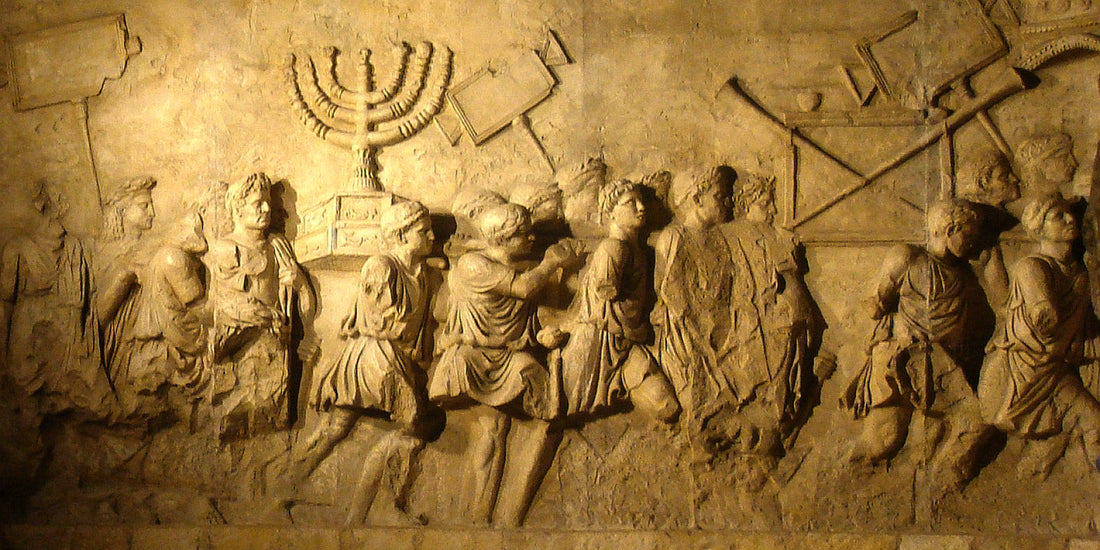
The Menorah
The Menorah (or Menorah), the seven-branched candlestick, has been a religious symbol of Judaism for thousands of years and dates back to the escape of the Jews from Egyptian slavery: during the forty-year journey, the Jews carried a Menorah with them, which was eventually placed in the Temple in Jerusalem.
The menorah is also the official emblem of the State of Israel. It represents enlightenment, insight, and the light of teaching. In the synagogue, it represents the Temple in Jerusalem.

Origins and biblical meaning
The origins of the menorah date back to the Torah, where it is described in the Book of Exodus (Exodus 25:31-40). There, G-d commands Moses to make a seven-branched lampstand of pure gold to be placed in the Tabernacle, the portable sanctuary. (Tabernacle) used by the Israelites during their desert wanderings after the Exodus from Egypt. This lamp was meant to burn continuously as a symbol of eternal light and divine presence.
The design of the menorah, with its central shaft and three branches on each side, is rich in symbolic meaning. Scholars and rabbis have offered various interpretations, stating that the menorah represents the burning bush seen by Moses, the Tree of Life, or the divine light that spreads wisdom and enlightenment.

The Rededication of the Second Temple
The menorah played a central role in Jewish worship both after the construction of the First Temple in Jerusalem by King Solomon and later in the Second Temple, which was rebuilt after the Babylonian exile. It stood in the sanctuary of the Temple, where it was cared for by the priests and remained a central element of the sacred rituals.
The menorah is central to the Hanukkah festival, albeit in its nine-branched form: Hanukkah commemorates the rededication of the Second Temple in 164 BC by the Maccabees after their victory over the Hellenistic Seleucid Empire. According to the Talmud, a miracle occurred during this rededication: Although there was only enough consecrated oil to keep the menorah burning for one day, the menorah miraculously burned for eight days, until a new supply of oil could be prepared. This event is celebrated with the nightly lighting of the Hanukkah menorah, which has nine branches—eight for each day of the miracle and one for the shamash (auxiliary candle).

Modern symbolism
After the Roman destruction of the Second Temple in 70 AD, the menorah became a powerful symbol of Jewish identity and continuity. The Arch of Titus in Rome depicts Roman soldiers carrying the Temple menorah as spoils of war, a vivid reminder of both the loss and the enduring hope of the Jewish people.
Today, the menorah remains a symbol of Judaism and the Jewish people. It features prominently in the emblem of the State of Israel and reflects the nation's attachment to its ancient heritage and its striving for a future of enlightenment and peace. The menorah is also a common motif in Jewish art, synagogue furnishings, and religious objects.

Religious and cultural significance
The light of the menorah represents more than just physical illumination; it is a symbol of spiritual enlightenment, wisdom, and divine inspiration. Lighting the menorah, especially at Hanukkah, commemorates the miracle of survival and faith despite overwhelming circumstances. It is a call to bring light to the world through good deeds, learning, and the pursuit of justice, and it reminds us of G-d's presence among humanity.
The menorah's constant presence in Jewish life, from ancient times to the present day, underscores its profound historical and religious significance. It is a beacon of continuity, resilience, and hope, embodying the core values and spirit of Judaism.

